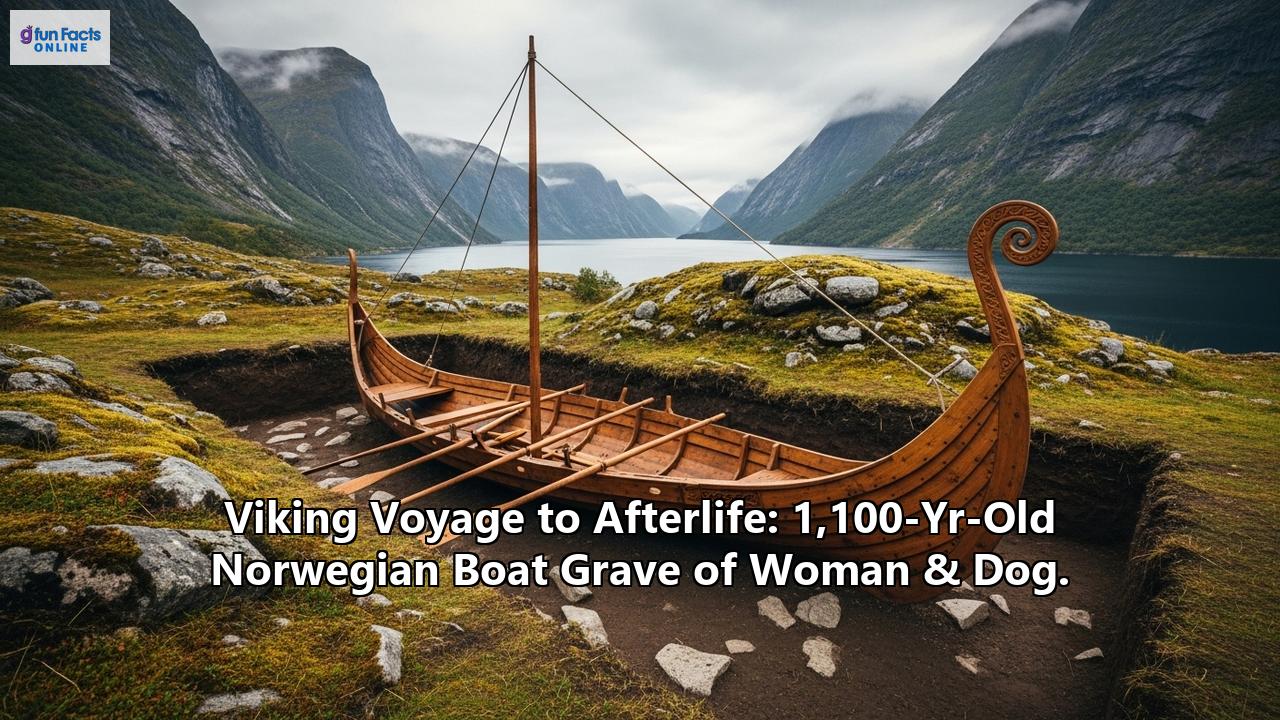In a captivating discovery on the remote Norwegian island of Senja, archaeologists have unearthed an 1,100-year-old Viking boat grave, revealing the final resting place of a woman of notable local standing and her faithful canine companion. This remarkable find, dating back to around 900-950 CE, offers an intimate and poignant glimpse into Viking burial customs, social hierarchies, and the deeply personal bonds between humans and animals during this storied era.
The journey to this significant find began a few years ago when metal detectorists exploring a low embankment on Senja Island stumbled upon two bronze bowl-shaped brooches and exposed rib bones just beneath a thin layer of soil. This chance discovery prompted archaeologists from the Arctic University Museum of Norway to investigate further. Full excavation commenced in May 2025, spurred by the landowner's plans to expand a nearby garage, which underscored the urgency to preserve the site. The grave lay remarkably close to the surface, a mere 20 to 30 centimeters deep, and could easily have been lost to ploughing or construction.
The burial itself was a wooden boat, approximately 5.4 meters (18 feet) in length. Interestingly, the boat was constructed mostly without iron rivets, with planks likely fastened using other materials, a technique known as a "sewn boat". Though the wood has long since decomposed, its outline remained visible as darker areas in the sand, allowing archaeologists to discern its form.
Within this ancient vessel, the remains of a woman were found, carefully laid on her side with her knees bent and arms in front of her. At her feet lay the skeleton of a small dog, possibly her cherished pet. Archaeologist Anja Roth Niemi from the Arctic University Museum of Norway noted, “The dog appears to have been placed with great care.” While not unheard of, the inclusion of dogs in Viking graves is relatively rare, adding a deeply personal dimension to this burial.
The woman was interred with a variety of artifacts that speak to her elevated social standing. These included two ornate oval brooches adorned with silver thread, typical women's jewelry of the Viking Age. Near her skull, a ring-shaped pendant was discovered, possibly once part of an earring or a decorative headpiece. Other items found were beads made from amber or bone, an iron sickle, a whetstone made of slate (both tools associated with agriculture), and an object made of whale bone, possibly a weaving sword – a tool linked to textile production. According to Niemi, overseeing textile production was traditionally a responsibility of the lady of the household. These grave goods suggest the woman held a significant, though perhaps not top-tier elite, status within her community. "Only the elite would receive a burial like this," Niemi stated, adding that some researchers believe only one or two individuals per generation were afforded such elaborate boat burials with valuable objects.
The presence of the dog is particularly evocative. Viking sagas and other historical sources suggest that dogs were highly valued by the Norse, not just for practical purposes like hunting and herding, but also as loyal companions. There are accounts of prominent individuals going to great lengths to care for their dogs in life and honoring them in death. In Norse mythology, dogs like Garm were associated with the afterlife, sometimes depicted as guardians of the underworld or companions on the journey to realms like Valhalla. The careful placement of the dog in this Senja grave may reflect such beliefs, or simply the profound emotional bond between the woman and her animal. Archaeologist Arild Klokkervoll has noted that dogs are frequently found in Iron Age graves in Northern Norway, often seen as companions in life and in the journey to the afterlife.
Viking burial customs were diverse, varying by social status, wealth, gender, and location. Boat graves, like this one, were a significant and often elite form of burial, symbolizing a vessel for the deceased's journey to the afterlife. Famous examples like the Oseberg ship burial also contained high-status women and animal sacrifices, including dogs and horses. The inclusion of grave goods—items of daily use, tools, jewelry, and weapons—was common, believed to be necessary or useful for the deceased in the next world. This particular grave on Senja is considered a "flat-ground grave," meaning it lacked a burial mound, which was more typical. Such graves are valuable to researchers as they are often undisturbed.
The well-preserved bones in the Senja find are also noteworthy, as Northern Norway is known for conditions favorable to skeletal preservation. This allows for potentially more detailed analysis of the individuals buried. Researchers plan to analyze the remains to learn more about the woman's life, her health, and the society she inhabited. They also hope to identify the breed of the dog and determine how it died.
This 1,100-year-old Viking boat grave, with its human and canine occupants and accompanying artifacts, paints a vivid picture of personal identity, status, companionship, and beliefs in Viking Age Norway. It underscores the importance of women in this society and offers a touching testament to the enduring connection between humans and their animal companions, a bond that evidently transcended even death in the Viking world.
Reference:
- https://arkeonews.net/archaeologists-uncover-1100-year-old-viking-boat-grave-of-woman-and-her-dog-on-senja-island-norway/
- https://www.sciencenorway.no/viking-age-archaeology-culture/a-viking-woman-was-buried-here-with-her-dog/2515330
- https://nordictimes.com/culture/woman-and-dog-found-in-norwegian-viking-grave/
- https://ground.news/article/woman-and-dog-found-in-viking-age-boat-grave-on-senja
- https://www.worldhistory.org/article/1313/norse-pets-in-the-viking-age/
- https://svalinn.com/history-of-working-dogs
- https://beautifulbeasts.com.au/blog/all-dogs-go-to-valhalla/
- https://www.vaia.com/en-us/explanations/history/viking-history/viking-burial-customs/
- https://www.asncvikingage.com/burial-practices
- https://archaeology.org/issues/march-april-2020/digs-discoveries/digs-viking-ship-burials/

